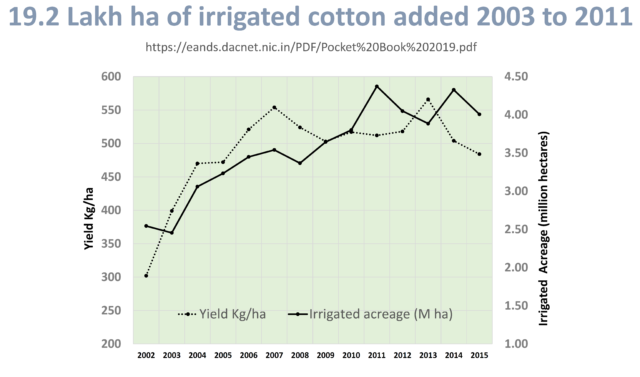The Failure of GMO Bt cotton and the continued success of Native Indigenous Cotton in India
A Briefing Paper of RFSTE* based on a 35-year study in Vidarbha’s Cotton Suicide belt
–
India is a paradise of rich diversity in ecosystems, food, cultures etc., and particularly has been a hub of indigenous agricultural practices that has evolved over thousands of years. Earth care is ingrained into the Indian philosophy of Vasudhaiv Kutumbakam – the Earth as one Family and all species as its members. Until the 1960s, our farmers produced bounties of food and fibre through indigenous farming methods of Earth Care. The agroecosystems were sanctuaries for living systems and species. From 1960s Green revolution introduced to India the high-yielding rice and wheat under the pretext of curbing hunger and poverty. Indian agricultural system was tagged as primitive and out-dated. Hoards of chemicals were forced upon farmers stating the soil was dead and did not provide nutrition for plants to grow. The multinationals kept claiming that without external inputs of high yielding varieties (HYV) of seeds and agricultural chemicals such as fertilizers and pesticides crop production and farmer incomes will suffer. Crop after crop of HYVs was being introduced.
Monsanto’s Illegal trials in India
In 1998 Monsanto entered a joint venture with Mahyco (Maharashtra Hybrid Seeds Company), the MMTB (Monsanto Mahyco Biotech (India) Pvt. Ltd. MMBT started the first illegal open field trials of genetically modified cotton seeds of Bt cotton in India and introduced Bt cotton in 40 locations across 9 states in the country. These trials were illegal since they were conducted without the approval of India’s apex body GEAC – Genetic Engineering Approval Committee.
| 24th April 1998 | Mahyco files to Department of Biotechnology for field trials |
| May 1998 | Joint venture between Mahyco and Monsanto formed |
| 13th July 1998 | Letter of Intent issued by DBT without involving Genetic Engineering Approval Committee (GEAC). |
| 15th July 1998 | Mahyco agrees to conditions in letter of intent |
| 27th July 1998 | Impugned permission by DBT for trials at 25 locations granted |
| 5th August 1998 | Permission for second set of trials at 15 locations granted. |
| 6th January 1999 8th | PIL filed by Research Foundation for Science Technology and Ecology (RFSTE) in the Supreme Court of India |
| 8th February 1999 | RCGM expresses satisfaction over the trial results at 40 locations. |
| 12th April 1999 | RCGM directs Mahyco to submit application for trials at 10 locations before Monitoring and Evaluation Committee. |
| 25th May 1999 | Revised proposal to RCGM submitted by Mahyco |
| June–Nov 1999 | Permission granted for different trial fields |
| Oct–Nov 1999 | Field visits |
| May 2000 | Mahyco’s letter to GEAC seeking approval for “release for large scale commercial field trials and hybrid seed production of indigenously developed Bt cotton hy- brids”. |
| July 2000 | GEAC clears for large scale field trials on 85 hectares and seed production on 150 hectares and notifies through press release. |
| October 2000 | RFSTE filed an application for amendment in the petition challenging the fresh GEAC clearance. |
| 18th October 2001 | GEAC orders uprooting of « Navbharat-15 », which was found to contain transgenic Bt. |
| 26th March 2002 | 32nd meeting of the GEAC was held to examine the issue of commercial release of Bt cotton. Members of ICHR, Health Ministry, Commerce ministry, CSIR, ICAR did not attend the meeting. In spite of the absence of important members of the GEAC, approvals were granted to three out of 4 of Monsanto- Mahyco’stransgenic hybrids. |
| 5th April 2002 | Formal approval granted to Mach-12, Mach-162 & Mach-184 by A. M. Gokhale, Chair of GEAC. Order of 05.04.2022 is a conditional clearance valid for three years. The stipulated conditions/restrictions are a clear implied admission on the part of the government that the tests are far from complete. In effect, the commercialisation was an experiment. MMTB had been asked to gather further data and submit annual reports on the resistance that the insects develop over a period of time to GM seeds and to conduct studies on resistance to bollworm, susceptibility tests, and tests for cross pollination. |
| 2 March 2005 | In March RFSTE releases results of continued failure of Bt cotton especially in Andhra Pradesh |
| 4 March 2005 | GEAC rejects renewal of the 3 Bt cotton varieties planted in the Southern states. However, other Bt varieties are cleared in Northern states. |
The date of sowing obtained from individual farmers’ by RFSTE showed that the the Bt cotton trials in the 40 locations across 9 states of India were not done before permission was granted by the Review Committee of Genetic Manipulation (RCGM). This was against scientific ethics with respect to the environment and was completely illegal. Gradually Monsanto, Syngenta, Aventis and DuPont controlled all the GM crops. Genetically modified crops have been introduced without understanding its ill effects on the ecosystem before its commercialisation.
A Trend of Bt cotton Failure
The increased cotton production trend from 2003-2005 was from native cotton farms and not Bt cotton cultivars.
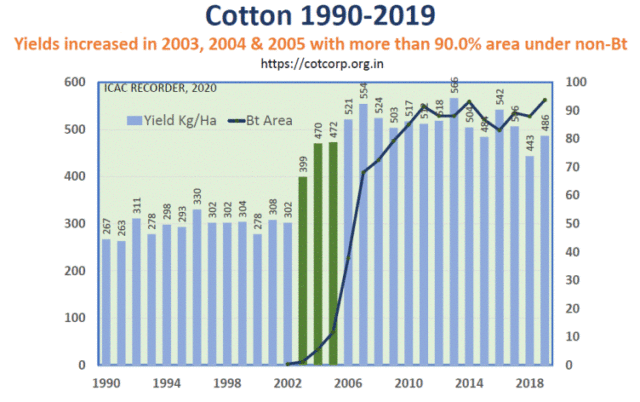
The trials of success that MMTB claimed in the early 2000s were made in selected farms that were already patronised by farmers in the past to try their hybrid seeds. So, these farmers were handpicked and the trials were carried out in their farms. All costs were borne by MMTB. Regional festivals were organised by MMTB to attract farmers to these trial plots in surrounding villages. Fields with exceptional cotton boll production were showcased. The cost of the technology was although hidden and farmers were instead lured to exchange their native indigenous cotton seeds. Thus, leaving them exposed to buy market seeds every season as they had lost their native indigenous varieties.
GMO Bt cotton and Chemicals- Trap of Debts, Displacement and Deaths from Suicide
Seed is the basis of Farmers’ livelihoods, the basis of agriculture, and the basis of life. In a span of 2 decades Monsanto plundered the diverse indigenous cotton varieties of Indian farmers and introduced Bt cotton extracting extravagant royalties from the farmers. The indigenous varieties of cotton were lost along with the other diversity of food crops that included millets, oilseeds and pulses that grew very well in the dry regions such as Vidarbha. Monsanto entered Indian farmlands illegally in 1998. By the early 2000s Monsanto depleted all the indigenous varieties of cotton and forced farmers to grow monocultures of Bt cotton. The price of cotton seeds rose from ₹5 – ₹9/kilogram to ₹ 1600 per 450 grams, which accounts to approximately 80000% increase in the cost of seeds. Moreover, the Bt cotton seeds came with a package of pesticides and fertilizers. Fertiliser and pesticide inputs only increased over the years.
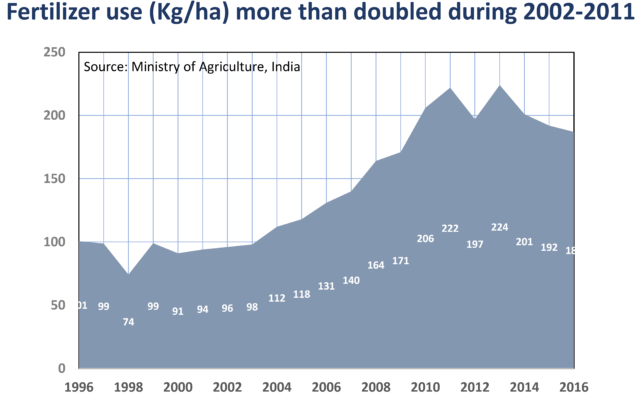
These external inputs trapped farmers to take loans since they could not afford the costly seeds of Bt cotton or the chemicals which promised high yields and pest management. Unable to repay banks and money lenders with high interest rates they sold their farmlands and in distress of land displacement and loan repayment were pushed to commit suicide. Until date there are over 400,000 farmers suicides recorded across India. In November 2021 there were 1056 suicides cases of farmers recorded from western Vidarbha alone. Thus, the farmers of Vidarbha and other Bt cotton growing regions in India were sucked into a vicious cycle of debts and suicides. Broken families, displacement of land were the ultimate outcomes, and no one took their responsibility.

It became evident that the yield under Bt cotton did not increase as claimed by Monsanto but the area of irrigated cotton that was added increased.
Bt cotton Failures end up with Mass Pesticide Poisoning Farmers
The GMO Bt cotton that was produced to deter the pests actually gave rise to new pests. The Bt cotton was engineered to repel the pink bollworms in cotton bolls, on the contrary it multiplied the resistant individuals and gave rise to sucking secondary pests which were not affected by the Bt toxin.

Source: Kranthi & Stone, 2020. Nature Plants. DOI: 10.1038/s41477-020-0615-5
The farmers in Vidarbha were reduced to a mind-set by multinationals that chemical pesticides are the only option to manage pests on crops. With BT Cotton failing consecutively in 2017 desperate farmers moved further to mix multiple chemicals and spray which lead one of the worst mass pesticide poisoning episodes in the history of Vidarbha in 2017. This came into the national media only after farmers’ deaths tolled over 10 in Yavatmal and number of casualties over 600. By the end of October 2017 over 800 farmers were hospitalised with mild to critical symptoms of poisoning and approximately 40 succumbed to it. Arni, Ghatanji, Kalamb, Pandharkawada were the other talukas following Yavatmal in pesticide poisoning. The scientific, academic and the multinationals blamed the lifestyle habits of farmers and claimed the pesticides or Bt cotton were not to be held responsible for the mass poisoning. Activists such as Mr. Kishore Tiwari pointed out that it was the complete fault of the American improved Bt cotton which failed the farmers who were forced to use not one but a mixture of pesticides in the hope to protect their produce. Mr. Tiwari pointed out that Agricultural and Health Department should support the farmers through mitigation measures to transition from Bt Cotton to growing native varieties through organic farming rather than that of the multinationals that look only for their profits and brush off any responsibility of their GMO and chemical technology.
But actual trends shown by the textile ministry and agricultural ministry data showed how yield subsequently decreased even with increased insecticide usage.

Source : Gutirrez & Rodrigues. 2019. https://www.currentscience.ac.in/Volumes/117/09/1422.pdf
Ecological disruption due to Bt cotton
Bt cotton crops disrupts Pollinators – A study carried out in 2013 by Navdanya showed that the pollinator and beneficial insects drastically declined in Bt cotton farms compared to organic biodiverse farms in Vidarbha. With ecosystem services such as pollination where 1/3rd of our food production comes from these species, crops such as Bt cotton and their package of chemicals will take no time to reduce our food abundances into a crisis.

Activity patterns of pollinator diversity in organic and Bt cotton (inorganic) farms
Their study also found the activity of pollinators varied in the two agro-ecosystems in Vidarbha region. The organic farms showed a greater activity earlier in the morning, a decrease in the forenoon followed by a gradual rise in the later part of the afternoon. This is commonly seen pattern in natural conditions where the insects use the early and later afternoon part of the day for their activities as it is energy efficient. Contrarily, in the Bt cotton farms the activity of pollinators was low in the morning and late afternoon. Greater activity was seen among insects in the afternoon. If we look at the pesticide application patterns, it is evident that most spraying is carried out earlier in the morning compared which is supposed to be the peak activity period of the insects. The Bt cotton crops and its pesticide application disrupt the natural cycles of insect activities and forces them to expend more energy on essential activities of foraging on hot afternoons. It is clearly observed from this study that Bt cotton completely disrupts Nature’s cycles for different species.
Bt cotton disrupts the survival of soil microorganisms- Another study by Navdanya in 2012 demonstrated that soils where non-Bt cotton crops were grown supported higher counts of microorganisms compared to soils where Bt cotton were cultivated. Thus, clearly pointing out that Bt toxin is harmful not only for the beneficial insects but also to the soil microorganisms.
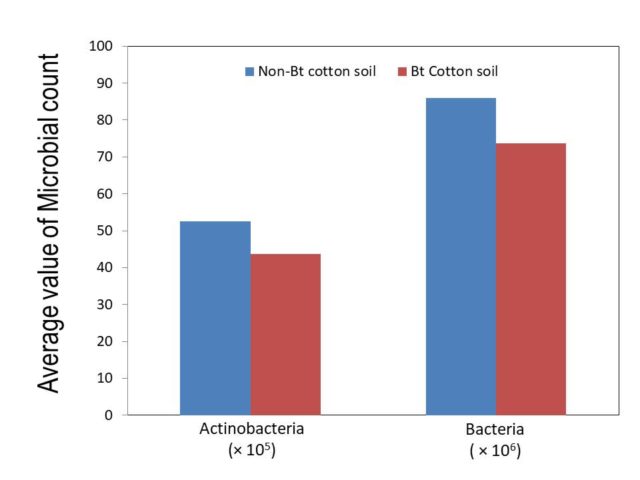
Source : Tarafdar et al. 2012. https://www.researchgate.net/publication/262183379_Effect_of_Bt-transgenic_cotton_on_soil_biological_health
Navdanya’s 35 years of relentless dedication to a cause brings hope to cotton farmers
Over the past 35 years Navdanya has been studying the crisis of Vidarbha GMO cotton growing farmers. By conducting several studies in economics, ecology and social aspects of Vidarbha farmers Navdanya has sought for solutions to the crisis of Vidarbha’s farmers. A study conducted in 2014 looked at how Bt cotton has affected the economies of the farmers.
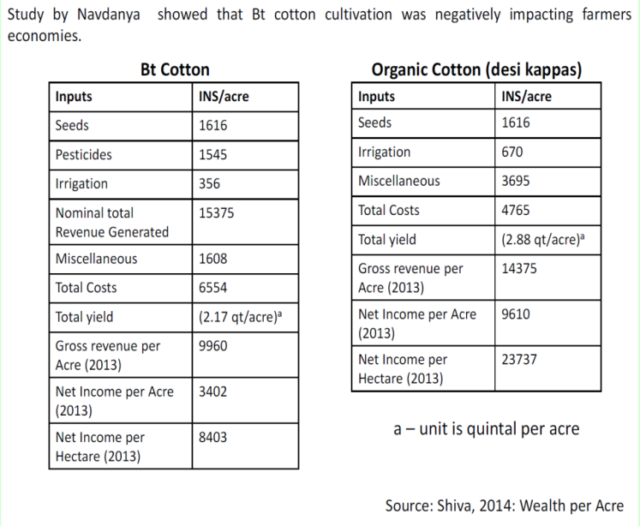
Latest trends in Bt cotton production – A Survey by Navdanya
In 2021 Navdanya conducted a comparative study on expenditure incurred and income generated in Bt cotton and Organic native indigenous cotton grown across Yavatmal and Amravati districts. The study clearly demonstrated how growing native indigenous cotton organically involves lower expenses while promising a decent income in comparison to Bt cotton.
Navdanya’s study on Bt cotton in Vidarbha showed how low the yields were even in the mid of its harvesting period. Farmers reported that by the middle of cotton harvesting they usually harvest up to 5-6 quintals. And then the harvest starts declining gradually until February. But in 2021 the the cotton production was utterly low due to bollworm infestations. By the time it was December 2021 when the cotton bolls were only in the middle of harvest time, farmers responded that they received productions as low as 0 to 2 quintals per acre of Bt cotton. The farmers harvest cotton until February end usually but were already planning to remove the Bt cotton crops after December 2021 harvest.

*Study by Navdanya from Yavatmal and Amravati districts of Vidarbha, Maharashtra in 2021
Navdanya worked towards bringing hope over the years through paths of transitioning to help farmers get back to their prosperous indigenous farming economies of millets, pulses, oil seeds and fibre crops. Navdanya also works with the widows of suicide farmers in areas of rejuvenating their family’s nutrition and economies through Gardens of Hope & Nutrition. The farmer communities save, produce and share their native indigenous seeds and do into depend on the markets. They also produce their their own internal farm inputs of organic pest control solutions, composts and cultures.
Studies showed that cotton production is dependent on the variability of rainfall. Lower rainfall gives rise to more variability in lint production. Soil fertility is important factor, but it is rainfall that ultimately governs lint production.
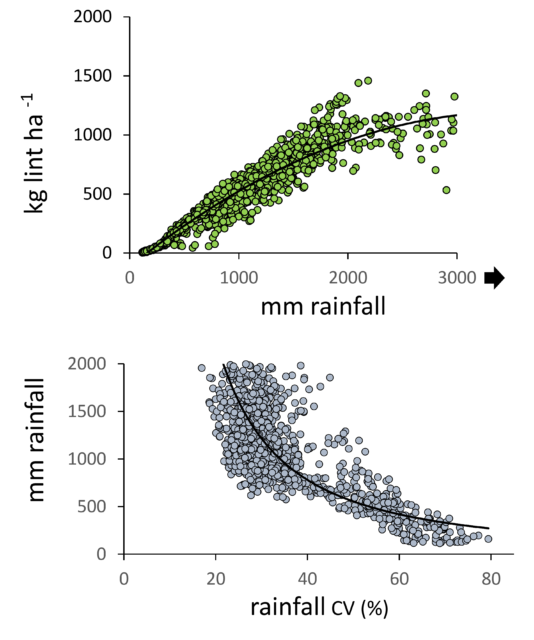
Scientists have demonstrated how multinationals have fooled the farmers by forcing them to adopt Bt cotton.
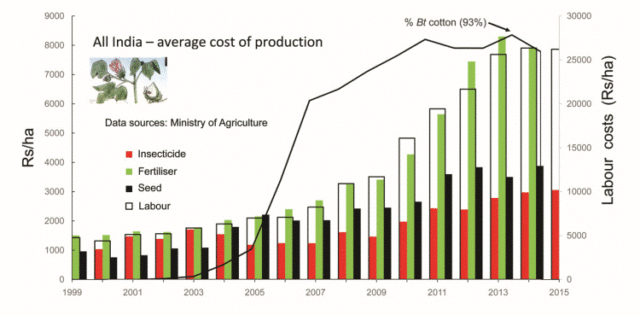
Source: Gutirrez et al. 2019. https://www.currentscience.ac.in/Volumes/117/09/1422.pdf
Average costs of production/ha in India. Bt area indicated by solid line.
Once can also observe from the latest review which shows that from 2014-2018 compared to previous years the yield and income have been dipping while the cost of production involving pesticides and fertilizers have been increasing over time.

Source: Najork et al. 2022. Agriculture and Human Values, DOI: 10.1007/s10460-022-10301-w
The cost of production and Acres, yield, income, pesticide usage, and fertilizer applications in 2014-2018 compared to those in the previous year (average Likert scale form -2 [strong decrease] to +2 [strong increase]) (n = 341-356, variation according to parameter and year).
Illegal entry of Herbicide tolerant Bt cotton (HTBT) – Illusion of profits
It is clear from these bitter past and present scenarios that GM crops that were put forward as a solution to the farmer’s woes was a social, economic and ecological heist of the farmers of India, deteriorating their condition further. The GM technology is for the corporates to reap profits and not to benefit the farmers. Similar to the monocultures of hybrids of Green Revolution in the sixties GMO BT cotton were forced upon Indian farmers, which eroded the diversity of nutritious, climate resilient crops, increased their dependence on market seeds, agrochemicals, and increased the risks of crops vulnerability to pest attacks and diseases. With this the cost of cultivation has escalated beyond the affordability of a farmer threatening the process of agriculture.
Now with Bt cotton failing time and again Monsanto is trying to get the HTBT – Herbicide tolerant Bt Cotton seeds to India. The seeds of HTBT are already being circulated illegally from Gujarat and being spread in Vidarbha by delivering it directly to the farmers. Since there is not approval market outlets selling seeds do not keep it in their shops but know the movement of HTBT seeds in their locality. It is important farmers are made aware about the Bt cotton menace and additionally the irreversible ill effects of herbicides such as Round Up and Roundup ready crops such as HTBT.
Boll Guard 3 Sham is No Way Forward!
Even with BG – 3 (Boll Guard 3) Bt cotton seeds the chances of cotton crops escaping the notorious Pink bollworm infestation are slim. Recent studies and inputs from farmers of Punjab one of the major cotton growers in Northern part of India throws light on the recurrent Pink bollworm infestation. It became clear when a farmer reported that he was lucky to detect the early signs of infestation in 2.5 acres out of the 5 acres of cotton crops he grew. Research organisations such as South Asia Biotechnology Centre (SABC) points out that there are three ways to mitigate the pink bollworm attack; mating disruption, releasing sterile males and use of BG-3 GMO Bt cotton. There is a fourth technique that is suggested which involves raising the pesticide sprays “exponentially”, which means spraying every 7-8 days. In the past the seeds used were stronger and fewer sprays were required. While now with the BG-3 Bt cotton variety it is suggested to use the 4 ways of mitigation to control pink bollworm attack. This doesn’t solve the costs of inputs on pesticides and seeds which have been increasing every year ripping the farmers off their incomes. It is now time that farmers reorganise and return to their roots of using indigenous cotton seeds that stand strong and resilient to the changing times.
* © Research Foundation for Science, Technology and Ecology-RFSTE, 2022
Further Reading:
- Shiva, V. Singh, V. 2015. Wealth per Acre. Independent Indian Publishing House. https://navdanyainternational.org/publications/wealth-per-acre/
- Shiva, V. Jalees, K. 2006. Seeds of Suicide. The Ecological and Human Costs of Seed Monopolies and Globalisation.https://books.google.co.in/books/about/Seeds_of_Suicide.html?id=tonaAAAAMAAJ&redir_esc=y
- Tarafdar et al. 2012. Effect of Bt-transgenic cotton on soil biological health. https://www.researchgate.net/publication/262183379_Effect_of_Bt-transgenic_cotton_on_soil_biological_health
- The Economic Times. 2022. These two issues could put the brakes on the Bt cotton story. https://economictimes.indiatimes.com/news/economy/agriculture/the-brakes-are-applied-on-the-bt-cotton-story/articleshow/62583116.cms?from=mdr
- Najork, K. et al. 2022. The Return of Pink Bollworm in India’s Bt Cotton Fields: Livelihood vulnerabilities of Farming Households in Karimnagar District. Progress and Development Studies. https://journals.sagepub.com/doi/full/10.1177/14649934211003457
- The Times of India. 2005. A disaster called Bt Cotton. https://timesofindia.indiatimes.com/edit-page/a-disaster-called-bt-cotton/articleshow/1313723.cms
- GM Watch. 2010. Bt Cotton has failed admits Monsanto. https://www.indiatoday.in/india/north/story/bt-cotton-has-failed-admits-monsanto-68749-2010-03-06
- Nair, P. 2013. Bt cotton: India’s crop of despair. https://fountainink.in/essay/bt-cotton-indias-crop-of-despair#:~:text=The%20genetically%20modified%20crop%20that,and%20farmer%20suicides%20have%20risen
- Suganya, K., & Nagendra, MS. 2020. Bt cotton failure in India. Krishi Science. https://www.researchgate.net/publication/344337221_BT_-COTTON_FAILURE_IN_INDIA
- Das, S. 2022. Illegal variety occupies about a fifth of GM cotton seed market. Financial Express. https://www.financialexpress.com/market/commodities/illegal-variety-occupies-about-a-fifth-of-gm-cotton-seed-market/2544367/
- Najork, K. et al. 2022. Bt cotton, pink bollworm, and the political economy of sociobiological obsolescence: insights from Telangana, India. Agriculture and Human Values. https://link.springer.com/content/pdf/10.1007/s10460-022-10301-w.pdf
- Gutierrez, A.P. 2020. The Failure of GMO Cotton in India. Resilience. https://www.resilience.org/stories/2020-09-09/the-failure-of-gmo-cotton-in-india/
- Byravan, Sujata. 2020. The twisted trajectory of Bt cotton. The Hindu. https://www.thehindu.com/opinion/op-ed/the-twisted-trajectory-of-bt-cotton/article32566091.ece#:~:text=According%20to%20the%20Ministry%20of,dwindling%20yields%20and%20pesticide%20expenses
- DTE Staff. 2019. Wrong to say Bt cotton successful in India: Environmental activists. Down to Earth. https://www.downtoearth.org.in/news/agriculture/wrong-to-say-bt-cotton-successful-in-india-environmental-activists-66604
- Kranthi, K. & Stone, G. 2020. Long-term impacts of Bt cotton in India. Nature Plants. http://dx.doi.org/10.1038/s41477-020-0615-5
- Vakudavath, C. B., et al. 2018. Field-evolved resistance of pink bollworm, Pectinophora gossypiella (Saunders) (Lepidoptera: Gelechiidae), to transgenic Bacillus thuringiensis (Bt) cotton expressing crystal 1Ac (Cry1Ac) and Cry2Ab in India. DOI: 10.1002/ps.5038
- Gutierrez, A. P., 2019. When biotechnologists lack objectivity. Current Science. https://www.currentscience.ac.in/Volumes/117/09/1422.pdf
- BT COTTON IN INDIA: MYTHS AND REALITIES: PRESENTATIONS, PRESS RELEASES AND THE VIDEO. https://csa-india.org/2020-bt-cotton-in-india-myths-and-realities-presentations-press-releases-and-the-video/; https://www.youtube.com/watch?v=i4o4clmQrDk
- GM Watch. 2020. International scientists highlight failure of GM Bt cotton in India https://www.gmwatch.org/en/news/archive/2020-articles/19522-international-scientists-highlight-failure-of-gm-bt-cotton-in-india
- Mukherjee, S. 2022. Pink bollworm threatens cotton crop again even as options to fight it taper. Business Standard https://www.business-standard.com/article/printer-friendly-version?article_id=122071900647_1

